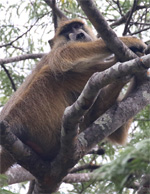|
 The Yellow Baboon is an old world monkey which inhabits savannas
and light forests in eastern Africa, from Kenya and Tanzania to
Zimbabwe and Botswana. Like other baboons, they are omnivorous,
with a preference for fruits; they also eat plants, leaves, seeds,
grasses, bulbs, bark, blossoms and fungi, as well as worms, grubs,
insects, spiders, scorpions, birds, rodents and small mammals. All
species of baboons are highly opportunistic feeders and will eat
virtually any food they can find. They have slim bodies with long
arms and legs, and yellowish-brown hair. Their hairless faces are
black, framed with white sideburns. Males can grow to about 84 cm,
females to about 60 cm. They have long tails which grow to be nearly
as long as their bodies. The average life span of the yellow baboon
in the wild is roughly 15-20 years; some may live up to 30 years.
They are diurnal, terrestrial, and live in complex, mixed-gender
social groups of 8 to 200 individuals per troop. They use at least
ten different vocalizations to communicate. When traveling as a
group, males will lead, females and young stay safely in the middle,
and less-dominant males bring up the rear. A baboon group's hierarchy
is a serious matter, and some subspecies have developed behaviours
intended to avoid confrontation and retaliation. For example, males
may use infants as a kind of "passport" or shield for safe approach
toward another male. One male will pick up the infant and hold it
up as it nears the other male. This action often calms the other
male and allows the first male to approach safely. They fulfill
several functions in their ecosystem, not only serving as food for
larger predators, but also dispersing seeds in their waste and through
their messy foraging habits. They have been able to fill a variety
of ecological niches, including places inhospitable to other animals,
such as regions taken over by human settlement. Thus, they are one
of the most successful African primates. However, their tendency
to live near people also means they are considered pests. Raids
on farmers' crops and livestock and other such intrusions into human
settlements have made most baboons species subject to many organized
extermination projects. Continued habitat loss forces more and more
baboons to migrate toward areas of human settlement.
The Yellow Baboon is an old world monkey which inhabits savannas
and light forests in eastern Africa, from Kenya and Tanzania to
Zimbabwe and Botswana. Like other baboons, they are omnivorous,
with a preference for fruits; they also eat plants, leaves, seeds,
grasses, bulbs, bark, blossoms and fungi, as well as worms, grubs,
insects, spiders, scorpions, birds, rodents and small mammals. All
species of baboons are highly opportunistic feeders and will eat
virtually any food they can find. They have slim bodies with long
arms and legs, and yellowish-brown hair. Their hairless faces are
black, framed with white sideburns. Males can grow to about 84 cm,
females to about 60 cm. They have long tails which grow to be nearly
as long as their bodies. The average life span of the yellow baboon
in the wild is roughly 15-20 years; some may live up to 30 years.
They are diurnal, terrestrial, and live in complex, mixed-gender
social groups of 8 to 200 individuals per troop. They use at least
ten different vocalizations to communicate. When traveling as a
group, males will lead, females and young stay safely in the middle,
and less-dominant males bring up the rear. A baboon group's hierarchy
is a serious matter, and some subspecies have developed behaviours
intended to avoid confrontation and retaliation. For example, males
may use infants as a kind of "passport" or shield for safe approach
toward another male. One male will pick up the infant and hold it
up as it nears the other male. This action often calms the other
male and allows the first male to approach safely. They fulfill
several functions in their ecosystem, not only serving as food for
larger predators, but also dispersing seeds in their waste and through
their messy foraging habits. They have been able to fill a variety
of ecological niches, including places inhospitable to other animals,
such as regions taken over by human settlement. Thus, they are one
of the most successful African primates. However, their tendency
to live near people also means they are considered pests. Raids
on farmers' crops and livestock and other such intrusions into human
settlements have made most baboons species subject to many organized
extermination projects. Continued habitat loss forces more and more
baboons to migrate toward areas of human settlement.
|
 The
Yellow Baboon - Issue
Forty-Four
The
Yellow Baboon - Issue
Forty-Four